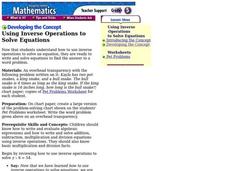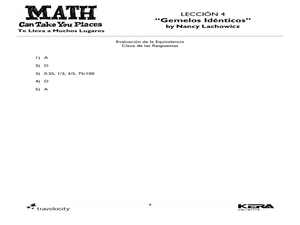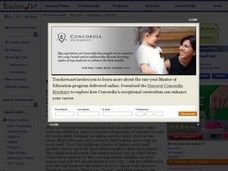Curated OER
Prime and Composite Numbers
Fifth graders investigate the concepts of composite and prime numbers. They factor different numbers and determine the number of factors for each. Based upon this information the number is declared prime or composite.
Curated OER
Prime and Composite Numbers
Fifth graders use prime factorization to identify prime and composite numbers. They use cubes to find factors. In groups, 5th graders draw rectangular arrays to discover prime numbers under 100.
Curated OER
Using Inverse Operations to Solve Equations
Fifth graders discover how to use inverse operations to solve equations. In this inverse operations lesson, 5th graders explore visual examples. Students also practice solving problems that their instructors model.
Curated OER
Helping Verbs
In this helping verbs review instructional activity, students review the list of 23 helping verbs and then identify the helping verbs in 10 sentences.
Curated OER
The Mesozoic Era
Sixth graders recognize that the Earth was different in different eras. In this Mesozoic Era activity, 6th graders compare the time frame of the different eras and how long they lasted for by graphing them. Students study the...
Curated OER
Cool Tools to Solve Challenging Word Problems
Young scholars solve math word problems. In this cool tools lesson, students are introduced to the K-N-W-S method. Young scholars work in groups and complete a worksheet using this method of learning.
Curated OER
Writing a Number Sentence
Third graders analyze word problems. In this number sentence lesson, 3rd graders evaluate word problems. Students create number sentences from word problems.
Curated OER
Fraction of a Number
Pupils explore how to multiply fractions using color tiles. They use the appropriate strategies for the multiplication of fractions. Students use 40 color tiles to practice multiplying fractions. They practice using various fractions to...
Curated OER
Exploring Multiplication and Division at a Party
Students solve multiplication and division problems using Unifix cubes. They explore multiplication and division through equal grouping of objects and sharing. Students discuss the task they completed and share how they completed the...
Curated OER
Relating Division and Subtraction
Third graders relate the process of division to subtracting equal groups. Through guided practice and teacher demonstration, they complete division problems using a subtraction method. Students complete problems independently for...
Curated OER
A Class Census
Students recognize that data represents specific pieces of information about real-world activities, such as the census. In this census activity, students take a class and school-wide census and construct tally charts and bar graphs to...
Curated OER
Tantalizing Tessellations Lesson III: Creating a Slide Translation
Students explore tessellations and the artwork of M.C. Escher. They view and discuss a video about M.C. Escher, create a slide template out of cardboard, and create a poster with their tessellation pattern.
Curated OER
Ratios, Mars and the Internet
Students calculate real ratios that exist between the planets Earth and Mars. After a lecture/demo, students use worksheets and access Internet sites to do their calculations.
Curated OER
Measuring Up on the Mayflower
Second graders use a meter tape to compare the length of the Mayflower to a basketball court and make homemade butter for crackers. Afterward, all students sit inside the makeshift Mayflower's dimensions and enjoy their Pilgrim butter.
Curated OER
Geography Journey
Fourth graders examine the geographic features that define places and regions and answer questions about the state of California. They discuss the components of a map legend and answer worksheet questions using a map of California as a...
Curated OER
Finding the Sum of the Exterior and Interior Angles of a Polygon
Students find the sum of the angles of a polygon and construct a polygon given the number of sides. In this polygon lesson plan, students draw large polygons on the floor of the room. They measure the length of each side and the interior...
Curated OER
Multiplication: Determining the Weight of Multiple Objects
Seventh graders use their knowledge of multiplication and problem solving to determine the total weight of multiple objects. In this multiplication lesson, 7th graders weigh various manipulatives, record the weight, and use...
Curated OER
A Polynomial Quilt
Tenth graders create polynomial quilts. In this polynomials lesson, 10th graders use concrete models, such as construction paper, to create various shapes described. Students use the FOIL method to multiply terms and to get a square...
Curated OER
A Plane Old Time
Fourth graders become familiar with a chart and use the information to create a flight plan. In this flight plan lesson plan, 4th graders access background knowledge of the role of flight controllers and the number concepts they use. ...
Curated OER
Pizza Party
Students explore the concept of fractions through use of hands on activity. In this lesson about fractions, students will work together in small groups with a round piece of paper, or pizza, and cut the pizza into pieces. Students will...
Curated OER
Identical Twins
Sixth graders work with equivalent fractions, decimals, and percents. In this equivalency lesson, 6th graders participate in a number of activities aimed at increasing their understanding of equivalent expressions. They form a human...
Curated OER
Ratios and Proportions
Students solve problems involving percents and ratios. In this algebra lesson, students convert decimals to percents and percents to decimals. They solve problems involving algebraic expressions and four different kinds of percent problems.
Curated OER
Scoot for Money
Students rotate through a group of centers counting the coins that are in a cup placed at each spot. After completing the entire circuit, papers are graded as a whole class and each student gets to spend the money in their cup at a class...
Curated OER
Solving Quadratic Equations
In this quadratic equations worksheet, 9th graders solve and complete 7 different problems that include factoring quadratics. First, they solve for the values of x that make the equation true. Then, students substitute their values into...

























